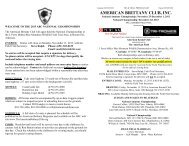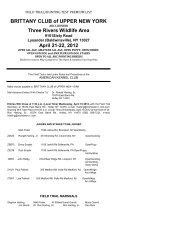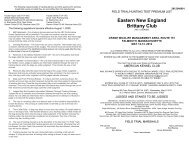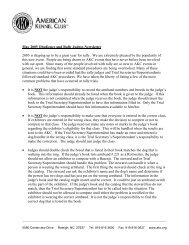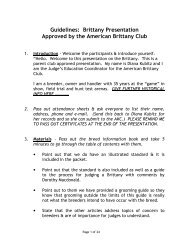The Skye Terrier - National Breed Clubs - American Kennel Club
The Skye Terrier - National Breed Clubs - American Kennel Club
The Skye Terrier - National Breed Clubs - American Kennel Club
Create successful ePaper yourself
Turn your PDF publications into a flip-book with our unique Google optimized e-Paper software.
Although some believe the Cairn <strong>Terrier</strong> evolved as a short-haired <strong>Skye</strong>,<br />
and that possibly the two are closely related, the Cairn is taller than the<br />
<strong>Skye</strong>, does not have as much hair, has a shorter body, less weight, and<br />
boasts a foxy facial expression. Actually, the <strong>Skye</strong> more closely resembles<br />
the Dandie Dinmont, except that the roach back of the Dandie<br />
Dinmont is a grave fault in the <strong>Skye</strong> <strong>Terrier</strong>. Most of the early <strong>Skye</strong>s<br />
were drop-eared and much smaller than the dogs of the present time.<br />
<strong>The</strong> head was not as large, nor the ears as feathered as in <strong>Skye</strong>s today.<br />
<strong>The</strong> weight averaged between ten and<br />
eighteen pounds.<br />
Historical information<br />
According to early references, Lady<br />
MacDonald of Armadale Castle in Sleat,<br />
on the southernmost tip of the Isle of<br />
<strong>Skye</strong>, owned an extraordinarily handsome<br />
strain of <strong>Skye</strong> <strong>Terrier</strong>. <strong>Breed</strong> mythology<br />
states that this line was descended from<br />
a cross of native Scottish <strong>Terrier</strong>s with<br />
some Spanish white dogs – probably<br />
of Maltese origins which had survived<br />
the wrecks of ships from the Spanish<br />
Armada. As far as this particular strain<br />
<strong>The</strong> MacDonald’s Armadale Castle on the Isle of <strong>Skye</strong>, in Scotland.<br />
is concerned, great care appears to have<br />
been taken to keep it pure and distinct<br />
from the breed common to the island. It is interesting to note that the<br />
dogs of this strain are described as having long, lank hair, almost trailing<br />
to the ground. <strong>The</strong> strength of this description probably indicates that<br />
the modern <strong>Skye</strong> evolved around 1588 or soon thereafter; with refinements<br />
following over the years. <strong>The</strong> early <strong>Skye</strong>s were aristocrats, in that<br />
they belonged only to the Lairds and were not kept by cottagers. <strong>The</strong>se<br />
hardy little working dogs were held in high esteem.<br />
<strong>The</strong> next reference appears in 1828, when it is recorded that <strong>Skye</strong><br />
<strong>Terrier</strong>s were found in abundance on the Isle of Wight, the Isle of <strong>Skye</strong><br />
and the Isle of Mull. White <strong>Skye</strong>s were particularly prized because they<br />
could be seen more readily at night. In 1837, Lady Fanny Cowper, then<br />
the Countess of Jocelyn, had a particularly beautiful fawn bitch that was<br />
looked upon as a model in her kennel on the Isle of Wight.<br />
Shortly after 1840 the breed became very popular during the reign of<br />
Queen Victoria. She owned many outstanding specimens, and many of<br />
her subjects followed her example. <strong>The</strong> <strong>Skye</strong> was introduced throughout<br />
Scotland and was firmly in place in drawing rooms of Victorian<br />
England by the 1850’s.<br />
Queen Victoria of England acquired her first <strong>Skye</strong> in 1839, and she<br />
was never without one for the rest of her life. As near as can be deter-<br />
page 5<br />
<strong>Skye</strong> <strong>Terrier</strong> <strong>Club</strong> of America







